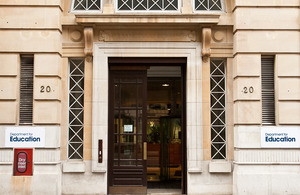Gibb: admissions statistics show there are too few good schools
Schools Minister Nick Gibb says too few pupils get their first choice.

More than 79,000 children have missed out on a place at their first-choice secondary school for this September, official statistics figures reveal today.
Schools Minister Nick Gibb said too many pupils – nearly one in six – would be going to a secondary school that was not their top choice.
The statistics break down the secondary school offers made to more than 512,000 children by 151 local authorities in England on 1 March.
They show that nationally:
- 84.6% of children received an offer at their first-choice school. This is up 1.4 percentage points on last year.
- 95.6% were offered a place at one of their top three preferred schools. This is a 0.7 percentage point increase on 2010.
This year there were far fewer children applying for a similar number of secondary school places. The number of children decreased by 17,500 on 2010 while there were 1,200 fewer places available.
Schools Minister Nick Gibb said:
More than 79,000 children missed out on their first choice of secondary school, nearly one in six of the entire year group, and more than 22,000 do not even get into any of their top three schools.
These figures expose the fact that there simply aren’t enough good schools.
Too many parents are forced to choose between schools which don’t deliver the academic standards and good behaviour they demand.
Yesterday’s OECD report underlined the serious problems in our school system and showed how far we have fallen behind other leading countries over the past decade. That is why we are restoring the integrity of the curriculum and exams, and giving more powers to teachers.
Our reforms to education, with a focus on raising standards of behaviour, trusting teachers and encouraging new schools to be established, are designed to deliver higher standards and genuine choice for parents.
Only when every school is regarded by parents as a good school will we be able to remove the anxiety parents suffer when choosing a school for their children.
Regional headlines
- The North East had the highest percentage of first preference offers at 94.3%
- Greater London had the lowest percentage at 66.2%.
Specific local authorities
- the Isle of Wight had the highest percentage of first preference offers, at 100%, followed by Cornwall and North East Lincolnshire with 99% and Central Bedfordshire with 98.6%
- apart from City of London (where there are no secondary schools), Slough had the lowest percentage of first preference offers at 46.2%, followed by Southwark (52.5%) and Wandsworth (55.5%)
- the biggest increase in first-choice preferences being met was in Trafford (11.5 percentage points), then North East Lincolnshire (11.4 percentage points)
- the biggest decrease in a first-choices preferences being met was Westminster (down 7.7 percentage points), followed by Kensington and Chelsea (6.6 per cent) and Camden (6.5 percentage points).
London headlines
Bexley had the highest percentage of first preference offers at 81.1%, followed by Newham at 79.9%. Apart from City of London (where there are no secondary schools), Southwark had the lowest percentage at 52.5%, followed by Wandsworth (55.5%).
Notes to editors:
The statistics can be found on the Department’s school applications statistics web pages. Parents have the right of appeal against any application that has been turned down.
DfE media enquiries
Central newsdesk - for journalists 020 7783 8300